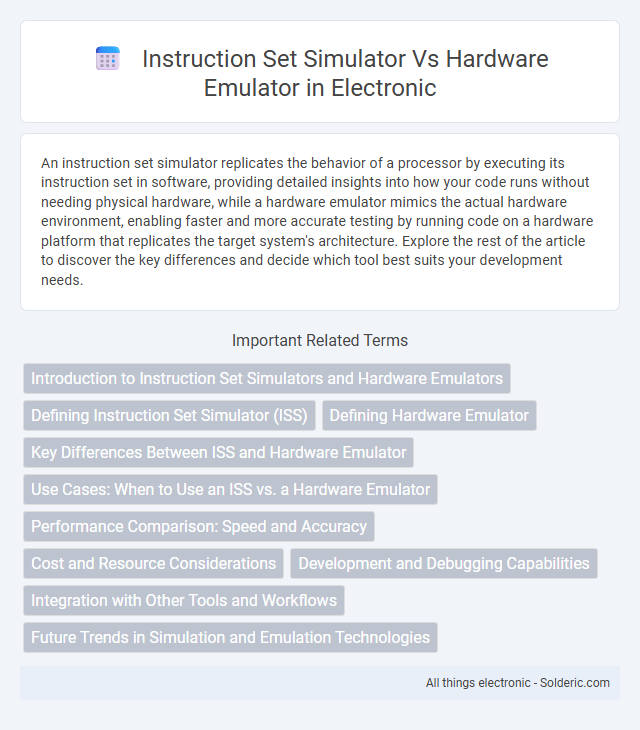An instruction set simulator replicates the behavior of a processor by executing its instruction set in software, providing detailed insights into how your code runs without needing physical hardware, while a hardware emulator mimics the actual hardware environment, enabling faster and more accurate testing by running code on a hardware platform that replicates the target system's architecture. Explore the rest of the article to discover the key differences and decide which tool best suits your development needs.
Comparison Table
| Feature | Instruction Set Simulator (ISS) | Hardware Emulator |
|---|---|---|
| Purpose | Simulates CPU instructions in software | Emulates hardware circuits using FPGA or ASIC |
| Speed | Slow, due to software-based simulation | Fast, near real-time hardware execution |
| Accuracy | High, cycle-accurate for instruction-level validation | Very high, hardware-accurate system validation |
| Use Case | Software development, early functional testing | Hardware verification, system integration testing |
| Debugging | Detailed instruction-level debugging | Limited debugging; hardware signals analysis |
| Setup Cost | Low, runs on standard computers | High, requires FPGA boards or dedicated hardware |
| Scalability | Limited by host CPU performance | Scales with hardware resources |
| Flexibility | High, easy to modify and update | Lower, hardware configuration changes are complex |
Introduction to Instruction Set Simulators and Hardware Emulators
Instruction set simulators (ISS) replicate processor instructions through software, enabling developers to test and debug code without physical hardware. Hardware emulators provide a physical environment that mimics system hardware at the register-transfer level (RTL), offering faster execution and more accurate timing compared to ISS. Both tools are essential for early-stage embedded system development, facilitating design validation and performance analysis before silicon fabrication.
Defining Instruction Set Simulator (ISS)
An Instruction Set Simulator (ISS) is a software tool that models the behavior of a processor's instruction set architecture (ISA), enabling developers to execute and test software without physical hardware. ISS provides precise simulation of instruction execution flow, facilitating debugging and performance analysis at the machine code level. Unlike hardware emulators, ISS operates entirely in software, which allows rapid iteration but may sacrifice real-time performance accuracy.
Defining Hardware Emulator
A hardware emulator is a physical device that replicates the behavior of a target hardware system, enabling developers to test and debug designs in real time with accurate execution timing and hardware interaction. Unlike instruction set simulators that simulate only the software environment, hardware emulators provide cycle-accurate signal-level visibility and hardware-level debugging capabilities. Your development process benefits from faster verification cycles and early detection of hardware-related issues through hardware emulation.
Key Differences Between ISS and Hardware Emulator
Instruction Set Simulators (ISS) execute software by simulating the processor's instruction set architecture (ISA) in software, providing detailed debugging and analysis capabilities at the code level, but with slower execution speed compared to real hardware. Hardware emulators replicate the target hardware design using FPGA or ASIC prototypes, enabling high-speed verification and testing of complex system behaviors with near-real-time performance, ideal for hardware-software co-design and validation. Key differences include execution speed, with ISS offering slower but more precise simulation, and hardware emulators delivering faster, cycle-accurate modeling to validate hardware functions before silicon fabrication.
Use Cases: When to Use an ISS vs. a Hardware Emulator
Instruction set simulators (ISS) are ideal for early software development and debugging when hardware is not yet available, enabling detailed code-level analysis and testing. Hardware emulators excel in validating system-level functionality and performance by providing cycle-accurate and real-time behavior of the target hardware. You should choose an ISS for rapid prototyping and software verification, while a hardware emulator is suitable for complex hardware-software integration and system validation.
Performance Comparison: Speed and Accuracy
Instruction set simulators (ISS) typically offer higher accuracy by precisely modeling processor instructions at the software level, but they operate significantly slower than hardware emulators. Hardware emulators deliver faster execution speeds by mapping design logic directly onto FPGA or ASIC platforms, enabling near real-time performance with some trade-offs in low-level behavioral fidelity. The choice between ISS and hardware emulation depends on balancing the need for simulation accuracy against the demand for speed in system validation and debugging workflows.
Cost and Resource Considerations
Instruction set simulators require significantly fewer resources and are cost-effective since they run on standard development machines without specialized hardware. Hardware emulators demand substantial investment in dedicated, high-cost platforms and increased power consumption to replicate target hardware environments accurately. For budget-conscious projects, instruction set simulators offer an accessible alternative, whereas hardware emulators justify their expense with superior speed and accurate real-time performance analysis.
Development and Debugging Capabilities
Instruction set simulators provide a software-based environment that enables detailed examination of code execution and easy insertion of debugging breakpoints, offering granular control over software behavior. Hardware emulators replicate the physical behavior of target hardware, allowing for early system validation and real-time testing of hardware-software interactions, which is critical for uncovering timing-related issues. Your development process benefits from combining simulators for in-depth code analysis and emulators for realistic hardware validation to enhance debugging capabilities and reduce time-to-market.
Integration with Other Tools and Workflows
Instruction set simulators integrate seamlessly with development environments and debugging tools, allowing precise control over software execution and detailed inspection of registers and memory states. Hardware emulators provide faster execution and can be incorporated into hardware verification workflows, facilitating system-level testing and real-time performance analysis. Your choice depends on the required integration level with software or hardware development toolchains for efficient workflow management.
Future Trends in Simulation and Emulation Technologies
Instruction set simulators are evolving with advanced machine learning algorithms to enhance accuracy and reduce execution time, enabling more efficient software development cycles. Hardware emulators are increasingly integrating FPGA and ASIC technologies to offer higher fidelity real-time testing and support complex SoC verification. Future trends emphasize hybrid platforms combining simulation flexibility with emulation speed, driving innovations in AI-assisted debugging and scalable cloud-based virtual prototyping.
instruction set simulator vs hardware emulator Infographic

 solderic.com
solderic.com